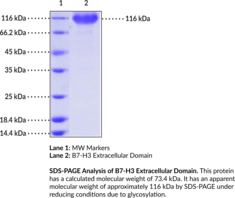Territorial Availability: Available through Bertin Technologies only in France
- Correlated keywords
- B7RP2 B-7RP2 B7-RP2 B-7RP-2 RP 4IgB7H3 4IgB7H-3 7H3 B7H3 CD-276 B7CD28 B7CD-28 B-7 H-3 AP1 NF?B IgG-1 Gly-27 HEK-293
- Product Overview:
B7-H3, also known as CD276, is a type I transmembrane glycoprotein and member of the B7-CD28 immune checkpoint protein family with roles in the T cell-mediated immune response.{52819,57242} It is encoded by CD276 in humans and is composed of an N-terminal signal peptide, an extracellular domain containing two identical pairs of immunoglobulin (Ig) constant (IgC) and variable (IgV) domains, a transmembrane region, and an intracellular tail. CD276 is ubiquitously expressed, however, protein expression is post-transcriptionally regulated.{57242} B7-H3 protein is constitutively expressed on non-immune fibroblasts, endothelial cells, and osteoblasts, and can be induced in immune cells such as dendritic cells, macrophages, natural killer (NK) cells, and T cells. It inhibits NK cell-mediated lysis, as well as induces co-inhibition of T cells, increases activation of tumor-specific cytotoxic T cells, and decreases proliferation of CD4+ and CD8+ T cells through modulation of nuclear factor of activated T cells (NFAT), NF-?B, and AP-1. Serum levels of B7-H3 are increased in patients with sepsis, as are intestinal levels in patients with graft versus host disease. High tumor levels of B7-H3 protein are associated with increased tumor size, poorly differentiated tumors, lymph invasion, and shorter overall survival in patients with lung and breast cancers.{52820} Cayman’s B7-H3/CD276 Extracellular Domain (human, recombinant) protein is a disulfide-linked homodimer. The reduced monomer, comprised of B7-H3 (amino acids 1-461) fused to human IgG1 Fc at its C-terminus, consists of 673 amino acids, has a calculated molecular weight of 73.4 kDa, and a predicted N-terminus of Gly27 after signal peptide cleavage. As a result of glycosylation, the monomer migrates at approximately 116 kDa by SDS-PAGE under reducing conditions.
Cayman Chemical’s mission is to help make research possible by supplying scientists worldwide with the basic research tools necessary for advancing human and animal health. Our utmost commitment to healthcare researchers is to offer the highest quality products with an affordable pricing policy.
Our scientists are experts in the synthesis, purification, and characterization of biochemicals ranging from small drug-like heterocycles to complex biolipids, fatty acids, and many others. We are also highly skilled in all aspects of assay and antibody development, protein expression, crystallization, and structure determination.
Over the past thirty years, Cayman developed a deep knowledge base in lipid biochemistry, including research involving the arachidonic acid cascade, inositol phosphates, and cannabinoids. This knowledge enabled the production of reagents of exceptional quality for cancer, oxidative injury, epigenetics, neuroscience, inflammation, metabolism, and many additional lines of research.
Our organic and analytical chemists specialize in the rapid development of manufacturing processes and analytical methods to carry out clinical and commercial GMP-API production. Pre-clinical drug discovery efforts are currently underway in the areas of bone restoration and repair, muscular dystrophy, oncology, and inflammation. A separate group of Ph.D.-level scientists are dedicated to offering Hit-to-Lead Discovery and Profiling Services for epigenetic targets. Our knowledgeable chemists can be contracted to perform complete sample analysis for analytes measured by the majority of our assays. We also offer a wide range of analytical services using LC-MS/MS, HPLC, GC, and many other techniques.
Accreditations
ISO/IEC 17025:2005
ISO Guide 34:2009
Cayman is a leader in the field of emerging drugs of abuse, providing high-purity Schedule I-V Controlled Substances to federally-licensed laboratories and qualified academic research institutions for forensic analyses. We are certified by ACLASS Accreditation Services with dual accreditation to ISO/IEC 17025:2005 and ISO Guide 34:2009.





